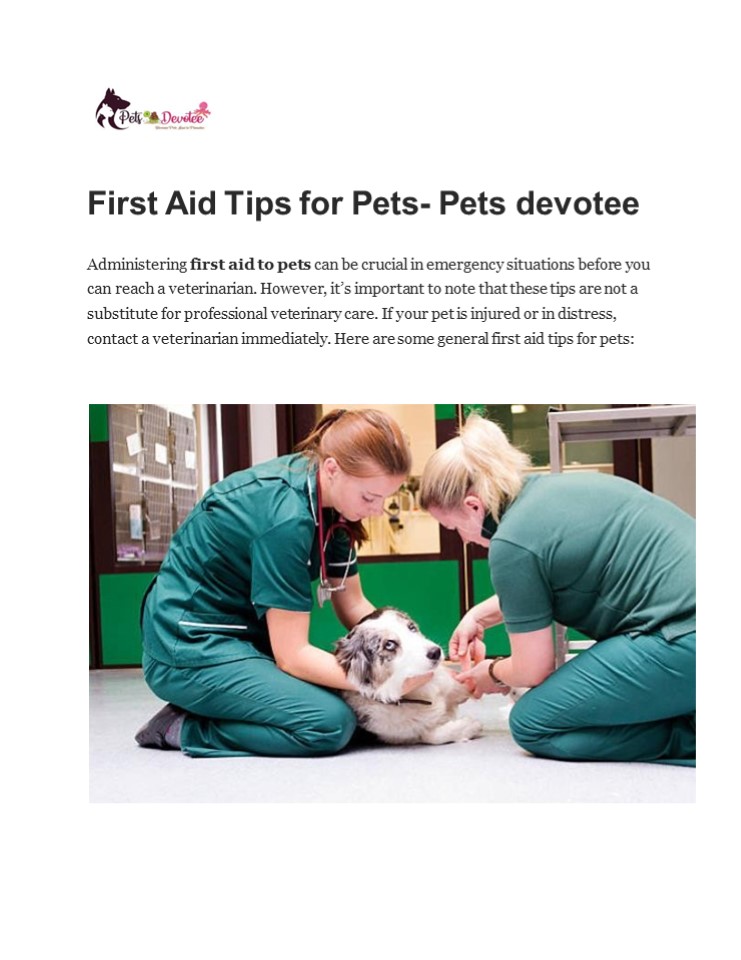First Aid Tips for Pets PowerPoint PPT Presentation
Title: First Aid Tips for Pets
1
First Aid Tips for Pets- Pets devotee
Administering first aid to pets can be crucial in
emergency situations before you can reach a
veterinarian. However, its important to note
that these tips are not a substitute for
professional veterinary care. If your pet is
injured or in distress, contact a veterinarian
immediately. Here are some general first aid tips
for pets
2
- Stay calm Your pet can sense your emotions, so
its essential to remain calm and composed
during a first aid situation. This will help keep
your pet calm as well. Know more First Aid Tips
and Preparedness Guide for Dogs - Assess the situation Before providing any first
aid, assess the situation and ensure its safe
for you and your pet. If there are any ongoing
hazards, such as traffic or aggressive animals,
move your pet to a safe location. - Muzzle your pet Even the gentlest pets may
become fearful or agitated when injured, which
can lead to unintentional bites. If your pet is
conscious and in pain, consider using a muzzle
or creating one with a makeshift material like a
bandage or a leash. - Control bleeding Apply gentle pressure to any
bleeding wounds using a clean cloth or sterile
gauze. If bleeding is severe or doesnt stop
within a few minutes, seek veterinary help
immediately. - Stabilize fractures If you suspect your pet has
a broken bone, try to stabilize the affected
area using a makeshift splint. Use padded boards,
rolled-up newspapers, or towels to create
support around the injured limb. Be careful not
to constrict blood circulation. - Handle with care Injured pets may be frightened
or in pain, so handle them with care. Use a
blanket or towel as a sling to transport larger
animals, supporting their weight and minimizing
movement. - CPR (Cardiopulmonary Resuscitation) Learn pet
CPR techniques from a reputable source or take a
pet first aid class. CPR can be crucial in cases
of cardiac arrest or respiratory distress.
Remember to perform CPR only if your pet isnt
breathing or doesnt have a heartbeat. - Poisoning If you suspect your pet has ingested
something toxic, contact your veterinarian or a
pet poison helpline immediately. Do not induce
vomiting unless specifically instructed by a
professional.
3
- Heatstroke In cases of heatstroke, move your pet
to a cool, shaded area. Wet their fur with cool
water and use a fan if available. Seek immediate
veterinary attention, as heatstroke can be
life-threatening. - Transporting If your pet requires immediate
veterinary care, transport them safely to the
veterinary clinic. Use a sturdy carrier or secure
them with a leash to prevent escape or further
injury during transport. - Choking If your pet is choking, carefully open
their mouth and check for any visible
obstructions. If you can safely remove the
object, do so. Be cautious not to push the
object further down the throat. If you cannot
remove the object or your pet is still
struggling, seek immediate veterinary
assistance. - Eye injuries If your pet has an eye injury, do
not attempt to treat it yourself. Cover the
injured eye with a clean, damp cloth or gauze and
seek veterinary help promptly. Avoid applying
any ointments or medications without
professional guidance. - Burns and scalds Immediately flush the burned
area with cool water for several minutes to
alleviate pain and minimize tissue damage. After
rinsing, cover the area loosely with a clean,
non-stick bandage or cloth. Seek veterinary
attention for further evaluation and treatment. - Seizures During a seizure, ensure your pets
safety by removing any nearby objects that could
cause injury. Do not attempt to restrain your pet
or put your hands near their mouth, as they may
unintentionally bite. After the seizure, keep
your pet calm and contact a veterinarian. - Allergic reactions If your pet exhibits signs of
an allergic reaction, such as swelling, hives,
difficulty breathing, or vomiting, contact a
veterinarian immediately. Do not administer any
over-the-counter medications without
professional guidance, as some human medications
can be toxic to pets.
4
- Bee or wasp stings If your pet is stung, scrape
the stinger off the skin using a credit card or
a blunt object. Apply a cold compress to reduce
swelling and monitor your pet for signs of an
allergic reaction. Seek veterinary care if your
pet shows severe symptoms or if the stinger was
in the mouth or throat. - Paw injuries If your pet has a cut or injury on
their paw, clean the area gently with mild
antiseptic solution or clean water. Apply a clean
cloth or gauze pad to control bleeding and
secure it with a bandage or adhesive tape. Seek
veterinary attention for further evaluation and
treatment. - Ingestion of foreign objects If you suspect your
pet has swallowed a foreign object, do not
induce vomiting unless instructed by a
veterinarian. Some objects can cause more damage
coming back up. Contact your veterinarian for
guidance on the appropriate steps to take. - Remember, these tips are general guidelines and
cannot replace professional - veterinary care. Its always best to consult with
a veterinarian as soon as possible in emergency
situations.

